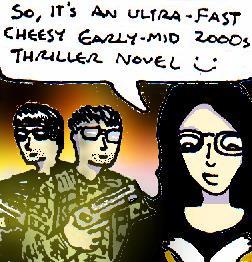Well, due to hot weather at the time of writing, I was in the mood for an ultra fast-paced “easy reading” thriller novel. So, naturally, I reached for the second-hand copy of Matthew Reilly’s 2003 novel “Scarecrow” that I’d found online shortly after I finished enjoying Reilly’s “Area 7” a few weeks earlier.
Although this novel is the third novel in Reilly’s “Scarecrow” series – following “Ice Station” and “Area 7” – it can technically be read as a stand-alone novel. However, some scenes and a few brief references will both matter more and make more sense if you’ve read the previous two novels.
So, let’s take a look at “Scarecrow”. Needless to say, this review may contain some SPOILERS.
The novel begins in London with a cabal of the richest and most powerful men in the world holding a secret meeting. They have compiled a list of fifteen names – including special forces soldiers, spies and terrorists from a variety of countries- and have put out the word to the international bounty hunting community that they will pay $18.6 million for the head of any person on that list.
Meanwhile, US Marine Captain Shane “Scarecrow” Schofield is on a plane to Siberia. The Russian government has asked for US help in dealing with a group of terrorists who have taken over an abandoned Cold War gulag/missile silo and are threatening to launch a missile from it. There is no word from the previous two US special forces teams that have been sent in to storm the compound. Worst of all, the radio suddenly goes down.
When Schofield arrives, he finds the bodies of the other two teams… and no terrorists. It doesn’t take him long to realise that he’s walked into some kind of trap. After all, his name is one of the ones on the list!
One of the first things that I will say about this novel is that it is a gloriously cheesy, ultra fast-paced and gleefully “over the top” thriller novel that was a lot of fun to read 🙂 However, it differs from the previous two novels in the series in a way which means that it doesn’t always feel quite as suspenseful or unique as “Ice Station” or “Area 7” do. Even so, this is still one hell of a thriller novel and it can easily put even the most spectacular modern action movies to shame.
So, I should probably start by talking about this novel’s thriller elements. As you would expect, this novel contains a lot of blisteringly fast and extremely spectacular set-pieces that are also backed up by several different types of suspense (eg: time limits, dangerous situations, Schofield literally being hunted etc..), lots of grittily brutal fight scenes and the kind of gloriously contrived high-stakes 1990s-style conspiracy theory plot that wouldn’t be entirely out of place in a Pierce Brosnan “James Bond” movie (or possibly even this awesome old computer game).
Like with Reilly’s other “Scarecrow” novels, all of this results in the kind of ultra-intense, compelling thriller story that will make pretty much every other thriller novel that you’ll read seem “slow paced” by comparison. It is like reading the kind of action movie Hollywood could only dream of ever making.
Like other books in the series, it is also as gloriously cheesy, stylised and “over the top” as you would expect – including everything from hilariously melodramatic nicknames for the bounty hunters (eg: “The Demon”, “The Black Knight” etc…), a few gloriously badass one-liners, numerous explosions, a shark pit, random sci-fi tech/weapons and other such things that are just brilliantly fun to read about – if you can suspend your disbelief. And, yes, you really need to suspend you disbelief to enjoy this novel. Trust me, it is well worth it 🙂
However, as mentioned earlier, this is probably my least favourite novel in the series so far. Why? Well, it has to do with the story’s scale and scope. One of the great things about the previous two books is that they each mostly take place within a single location (eg: An Antarctic research station and a secret desert base). Not only does this add a lot of extra claustrophobia, suspense and tension to these two novels, but it also means that the reader has a chance to really get to know the locations – deepening their immersion in the story, whilst also allowing Reilly to surprise them in all kind of ways.
On the other hand, “Scarecrow” takes place in a wide variety of different locations across the globe. Whilst I can see that Reilly wanted to make this novel “more spectacular”, this also means that it loses what made the previous two books so unique. In other words, this novel reads a lot like pretty much any other novel in the genre at times. For example, if you’ve read any of Clive Cussler’s modern co-written books (such as his “Oregon Files”, “Numa Files” etc… novels) or anything like that, then this Reilly novel won’t seem all that different. Yes, it’s still a really gripping thriller novel, but it just feels a bit less unique than the previous two books thanks to it’s globe-trotting plot.
In addition to this, the novel is a lot more of it’s time than I’d expected. Although the main plot still has some of the innocent 1990s-style silliness that you’d expect from this series, it is both a lot more “topical” and, like many other things from the early-mid 2000s, a bit “gloomier” and “edgier” than previous books in the series too. When this is at it’s best, it allows for a genuinely shocking plot twist or two, it allows Reilly to play with the reader’s expectations a bit and also to add a little bit of extra emotional depth to the series too.
On the other hand, this “edgier” tone also leads to some very predictable and overwrought “dramatic” moments. Likewise, some parts of this novel haven’t aged as well as Reilly’s “Ice Station” or “Area 7” and will probably come across as a bit “politically incorrect” when read today. Some of this is probably due to the historical context (eg: the fear and conservatism of the early parts of the “War On Terror”) and the rest can probably be attributed more to clumsiness than malice (eg: a cringe-worthy phonetic accent during one scene, some two-dimensional characters etc…), but it is still a novel that hasn’t aged entirely well.
In terms of the characters, although you shouldn’t expect in-depth characterisation from a Matthew Reilly novel, there was a little more characterisation here than I’d expected. Most of this, of course, focuses on Captain Schofield – and the novel uses the corny narrative trope of using other characters as tools to give him a bit more depth. Whether it is another character that shows what he’d have turned into if his past was slightly different, a tragic death that allows him to express his emotions (in an incredibly melodramatic way) or scenes that cause other characters to tell him how great he is, this isn’t exactly subtle or nuanced characterisation, but it is a welcome change and it adds a little bit more depth to his character.
As for the writing, it is a Matthew Reilly novel 🙂 In other words, it is one of the best “badly written” novels that you’ll ever read. Like with Reilly’s other thriller novels, this novel’s highly informal and ultra fast-paced third-person narration breaks all sorts of stylistic rules and yet still remains incredibly readable and compelling throughout 🙂
The writing style is, at the same time, both incredibly immature and yet sophisticated enough to keep the story flowing at a hundred miles an hour. This is really difficult to describe well, but Reilly’s writing style is a “love it or hate it” kind of thing that you’ll either really enjoy or which will make you throw the book across the room. And, with the exception of a few egregious mistakes (such as the phonetic accent I mentioned earlier), I really enjoyed the writing style in this book 🙂
In terms of length and pacing, this novel is excellent as always 🙂 Although it is a fairly hefty 524 pages in length, this novel moves so quickly that it feels like reading a much shorter novel 🙂 Likewise, this is a very well-structured thriller novel that never gets boring or really slows down too much either 🙂
All in all, this is a gloriously cheesy and “over the top” thriller novel that will also make most other thriller novels seem “slow-paced” by comparison. Yes, it lacks the brilliantly unique claustrophobic suspense of the previous two books in the series and it also hasn’t aged entirely well, but – these things aside – it is still a very compelling and enjoyable thriller novels that fans of authors like Clive Cussler will probably enjoy 🙂
If I had to give it a rating out of five, it would get a four.







